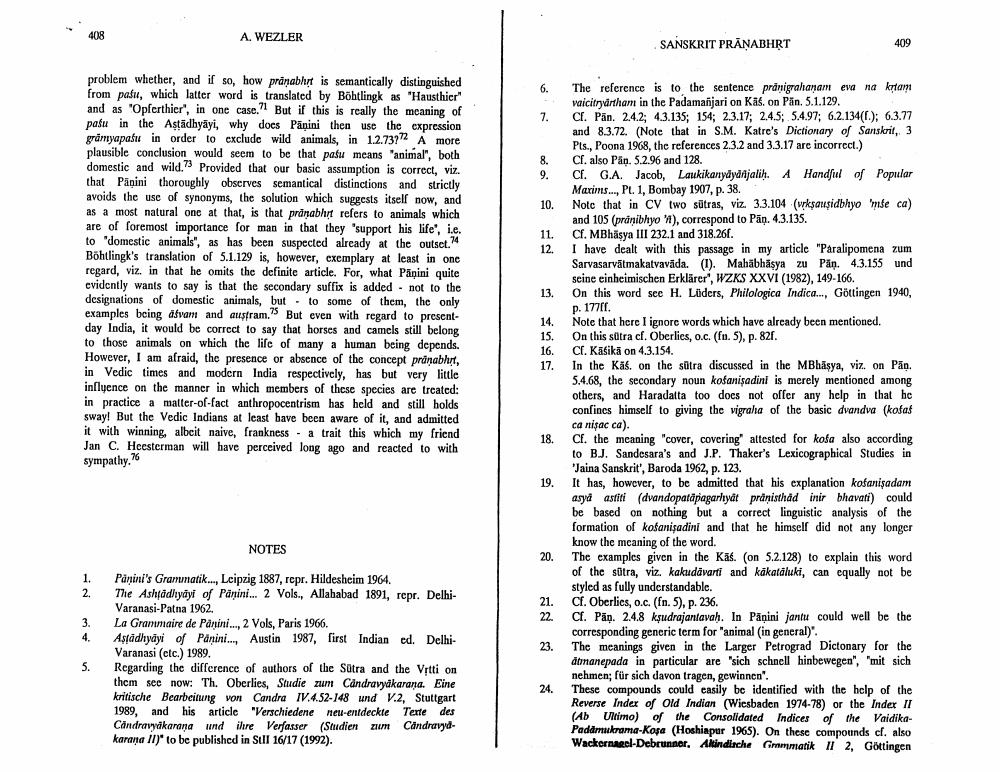Book Title: Sanskrit Pranabhrt Or What Supports what Author(s): A Wezler Publisher: A Wezler View full book textPage 9
________________ A. WEZLER SANSKRIT PRĀŅABHRT 409 6. 10. 11. problem whether, and if so, how prānabhrt is semantically distinguished from pafu, which latter word is translated by Böhtlingkas "Hausthier" and as "Opferthier', in one case. But if this is really the meaning of pasu in the Astādhyāyi, why docs Pānini then use the expression grārreyapafu in order to exclude wild animals, in 1.2.73?" A more plausible conclusion would seem to be that pašu means "animal", both domestic and wild." Provided that our basic assumption is correct, viz. that Panini thoroughly observes semantical distinctions and strictly avoids the use of synonyms, the solution which suggests itself now, and as a most natural one at that, is that prānabht refers to animals which are of foremost importance for man in that they 'support his life", i.e. to "domestic animals', as has been suspected already at the outset. Böhtlingk's translation of 5.1.129 is, however, exemplary at least in one regard, viz. in that he omits the definite article. For, what Pāṇini quite evidently wants to say is that the secondary suffix is added not to the designations of domestic animals, but - to some of them, the only examples being afvam and ausfram. But even with regard to presentday India, it would be correct to say that horses and camels still belong to those animals on which the life of many a human being depends. However, I am afraid, the presence or absence of the concept pranablurt, in Vedic times and modern India respectively, has but very little influence on the manner in which members of these species are treated: in practice a matter of fact anthropocentrism has held and still holds sway! But the Vedic Indians at least have been aware of it, and admitted it with winning, albeit naive, frankness - a trait this which my friend Jan C. Heesterman will have perceived long ago and reacted to with sympathy.26 13. 14. 15. 16. 17. The reference is to the sentence prdnigrahanam eva na krtam vaicitrydrtham in the Padamanjari on Kas on Pän. 5.1.129. C. Pẫn. 242, 43,135; 154; 23.17; 245; 5.497; 6.2134(); 6.3.7 and 8.3.72. (Note that in S.M. Katre's Dictionary of Sanskrit, 3 Pls., Poona 1968, the references 2.3.2 and 3.3.17 are incorrect.) Cl. also Pan. 5.2.96 and 128. Cl. G.A. Jacob, Laukikanydyddjalih. A Handful of Popular Maxims.... PL. 1, Bombay 1907, p. 38. Note that in CV two sutras, viz. 3.3.104 (rksauşidbhyo me ca) and 105 (pranibhyo ), correspond to Pān. 4.3.135. C. MBhäsya III 232.1 and 318.261. I have dealt with this passage in my article "Paralipomena zum Sarvasarvatmakatvavada. (1). Mahabhâsya zu Pan. 4.3.155 und scine einheimischen Erklärer', WZKS XXVI (1982), 149-166. On this word see H. Lüders, Philologica Indica..., Göttingen 1940, p. 17701. Note that here I ignore words which have already been mentioned. On this sütra cf. Oberlies, o.c. (fm. 5), p. 82. C. Kāśikā on 4.3.154. In the Kas on the sitra discussed in the MBhäsya, viz. on Pāṇ. 5.4.68, the secondary noun kofanisadini is merely mentioned among others, and Haradatta too does not offer any help in that he confines himself to giving the vigrala of the basic dvandva (kofaf ca nisac ca). Cr. the meaning "cover, covering altested for kofa also according to BJ. Sandesara's and J.P. Thaker's Lexicographical Studies in 'Jaina Sanskrit', Baroda 1962, p. 123. It has, however, to be admitted that his explanation kofanisadam asyd asti (dvandopardpagarhyat prdnisthad inir bhavati) could be based on nothing but a correct linguistic analysis of the formation of kofanisadini and that he himself did not any longer know the mcaning of the word. The examples given in the Käs. (on 5.2.128) to explain this word of the sitra, viz. kakudävarti and käkatáluki, can equally not be styled as fully understandable. Cf. Oberlies, o.c. (fn. 5), p. 236. a. Pāņ. 2.4.8 kşudrajantavah. In Pāņini jantu could well be the corresponding generic term for'animal (in general)". The meanings given in the Larger Petrograd Dictonary for the dtmanepada in particular are "sich schnell hinbewegen", 'mit sich nehmen; für sich davon tragen, gewinnen". These compounds could casily be identified with the help of the Reverse Index of Old Indian (Wiesbaden 1974-78) or the Inder II (Ab Ultimo) of the Consolidated Indices of the VaidikaPaddrukrama-Kopa (Hoshiapur 1965). On these compounds c. also Wackernarel-Debrunner, Altindische Commatik II 2, Göttingen 18. 19. NOTES 20. 21. 22. Panini's Grammatik..., Leipzig 1887, repr. Hildesheim 1964. The Ashfadhyāyi of Panini... 2 Vols., Allahabad 1891, repr. DelhiVaranasi-Patna 1962. La Granimaire de Panini..., 2 Vols, Paris 1966. Asfadhydy of Panini... Austin 1987, first Indian ed. DelhiVaranasi (ctc.) 1989. Regarding the difference of authors of the Sotra and the Vrtti on them see now: Th. Oberlies, Studie zum Candravydkarana. Eine kritische Bearbeitung von Candra IV.4.52-148 und V.2, Stuttgart 1989, and his article "Verschiedene neu-entdeckte Texte des Candravydkarana und ihre Verfasser (Studien zum Candrayydkarana II)" to be published in Sill 16/17 (1992).Page Navigation
1 ... 7 8 9 10 11
